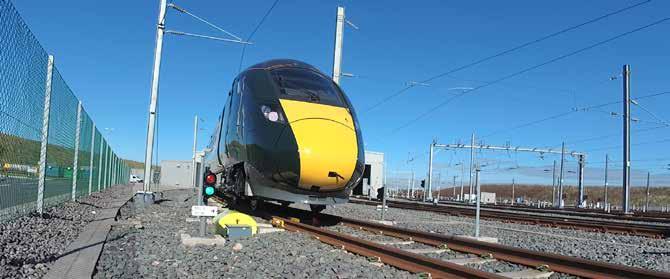40
ROLLING STOCK/DEPOTS
Exeter’s new depot a tight squeeze GRAHAME TAYLOR
E
xeter St. David’s goods yard was a reasonable size when it was first established back in the 1840s. But then it soon started to be nibbled away. By 1864, additional platforms were constructed for the adjacent station, as a result of
the arrival of three more railway companies.
Nothing much changed until the early part of the 20th Century, when further platform alterations took another chunk out of the southern end of the yard. With the River Exe all along the western side, the engine sheds to the south west and the running lines on the east, there really wasn’t much room left, apart from a narrow sliver of land. With the demise of steam, the engine sheds were converted into a diesel depot. This has room for a pair of diesel multiple units (DMUs) and a heavy maintenance shed that can take but a single carriage. As goods traffic dwindled, the goods lines were removed and the site became the typical railway blend of informal car parking, abandoned ‘stuff’ and a smattering of portable buildings.
More seats, more trains Then came the 2019 timetable change, which heralded an increase in passenger seating of over 50 per cent. Those additional seats meant additional and longer trains, and those additional and longer trains would need to be maintained. Fiona Cane, GWR’s head of commercial development, explained: “The trains have been cascaded as a result of
Rail Engineer | Issue 188 | Jan-Feb 2021
the delivery of new trains running under the wires between Paddington and Bristol - and the removal of the Class 143 Pacers that have…left the business.” Nice euphemism! As already mentioned, the existing DMU facility can deal with just two 2-coach trains. The new trains will not fit and to split a DMU to make it fit would add two hours to any maintenance routine. Something had to be done. And the ‘something’ was a brand-new depot, built to 21st century standards, capable of taking two to five coach units. A scheme was developed to GRIP4 (single option development) by RPS Group and a contract valued at £34 million awarded to main contractor Hochtief in December 2017. But, looking again at the diminished goods siding site, it was pretty obvious that it would all be a ‘bit of a squeeze’.
Tight Fiona, who spent over three years as senior project manager at the new depot, knows the site well: “The footprint of the new depot is almost as big as the footprint of the existing goods yard. “It isn’t just area that is a problem. Levels are critical. Trackwork has to join the existing connection into the main line. If the connection site changed, then this would have meant a change in the main line signalling. Timescales were tight enough, without bringing in an additional discipline.”













